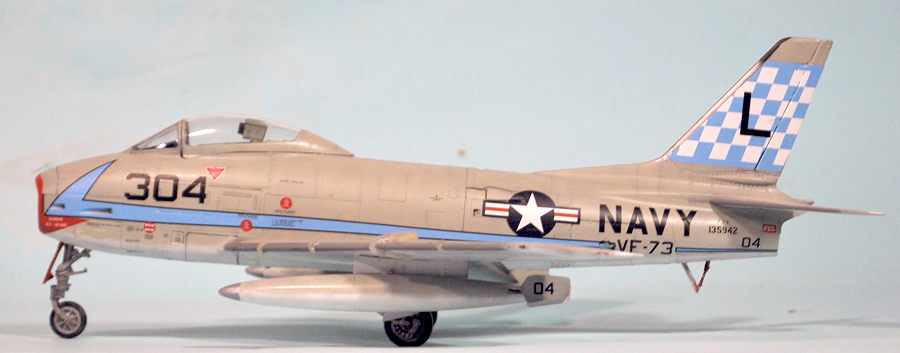
Kitty Hawk 1/48 FJ-3 Fury
| KIT #: | KH 80156 |
| PRICE: | $64.99 |
| DECALS: | Four options |
| REVIEWER: | Tom Cleaver |
| NOTES: | Caracal Decals CD48174 “FJ-3 Fury Part 2" |

| HISTORY |
By the end of November, 1950, the Navy knew that its main fleet fighter, the Grumman F9F-2 Panther, was seriously outclassed by the opposition. LCDR William T. Ament of VF-112 had shot down the first MiG-15 confirmed by the Soviet records (eat your heart out Russell Brown - the MiG-15 you “shot down” was dropping onto the main runway at Antung as you were climbing back to join your flight, no matter what the USAF continues to claim). Ament was the first to say it was dumb luck, that the enemy pilot could have avoided the entire encounter if he had climbed rather than dived. Ament’s airplane was close to out of control when he fired the final burst, and he missed by less than 100 feet making a twin hole in the mountainside right beside his victory. Two other successful Navy MiG kill claims that month were the result of better training on the part of the naval aviators and inexperience on the part of their opponents. Other than Royce Williams’ amazing 7:1 fight two years later in which he succeeded in downing four of his opponents in a triumph of pilot talent, the Panther was clearly not up to meeting a MiG-15 on an equal basis.
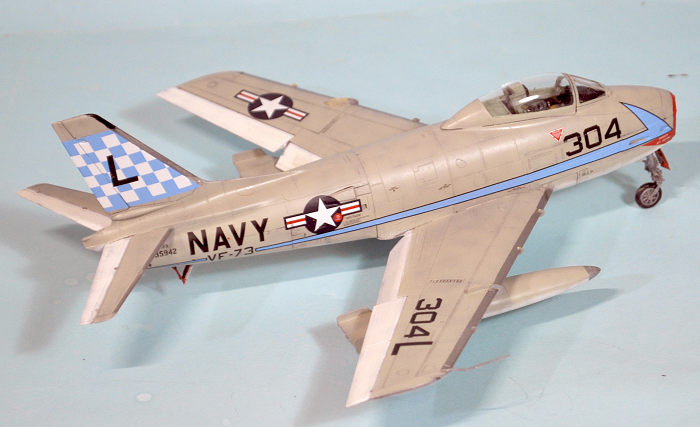 Grumman
had already convinced the Navy to put swept wings on the Panther, but the Cougar
was a good two years down the line from seeing operational service. The Navy was
desperate enough to get a competitive fighter that the Bureau of Aeronautics
finally went to North American and asked, “Please Mr. Kindelberger, can you make
us a Sabre we can put on an aircraft carrier? And do it fast?”
Grumman
had already convinced the Navy to put swept wings on the Panther, but the Cougar
was a good two years down the line from seeing operational service. The Navy was
desperate enough to get a competitive fighter that the Bureau of Aeronautics
finally went to North American and asked, “Please Mr. Kindelberger, can you make
us a Sabre we can put on an aircraft carrier? And do it fast?”
Having already taken note of the Navy’s air combat record over Korea, North American had already put some thought into whether the Sabre could be navalized, and had determined it could be. The F-86A had a lower landing speed and better low speed handling than the F9F-5 Panther Grumman was developing. The swept-wing Sabre had handling and stall characteristics at low speeds comparable to the best straight winged airplanes. Since no one at the time knew all the stresses a jet fighter would be subject to, the Sabre had been designed strong enough that modifying it to take the stress of carrier operations would not be that hard, other than beefing up the landing gear. The Navy ordered 300 “Sea Sabres” (later reduced to 200) known as the FJ-2 “Fury,” though its only connection to the FJ-1 was that both airplanes came from the same factory, before the first prototype took flight.
The first prototype to fly was actually the third aircraft ordered: designated XFJ-2B and first flown on 27 December 1951, it differed only from a standard F-86E-10 in its armament, having four 20-mm Colt Mk 12 cannons instead of the six Colt-Browning M3 .50 machine guns of the Sabre. The second and third aircraft to fly were designated XFJ-2 and lacked armament, but were modified to be carrier-capable with arrester hooks and longer nosewheel legs to increase angle of attack at take-off and landing, and catapult fittings. In August 1952, carrier trials were held on USS Midway (CVB-41), followed by carrier qualification trials on USS Coral Sea (CVB-43) in October–December 1952. Results were less than satisfactory, with low-speed handling considered poor, while the arrester hook and nose gear leg were too weak for extended carrier operation.
The first production aircraft flew on 22 November 1952. By now, the FJ-2 incorporated further modifications for carrier operations, with the main landing gear track widened by eight inches, the outer wing panels folding upward, and the windscreen modified to give the pilot a better view during approach. The FJ-2 also featured the F-86E’s "flying tail" without dihedral (thus ensuring there would be no catastrophic “blank-out” of the horizontal stabilizer in full-stall landing configuration), which made the FJ-2 the first carrier fighter capable of supersonic speed. The addition 650 pounds to airframe weight meant the FJ-2 was slightly underpowered as compared with its land-based cousin
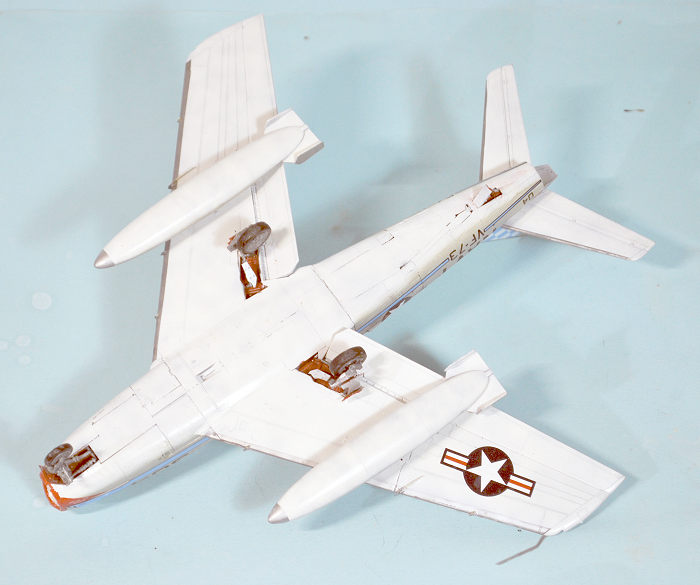 Development
of a version powered by the Wright J65, a license-built version of the British
Armstrong Siddeley Sapphire turbojet promised to deliver 28 percent more thrust
than the J47, for little gain in weight. The new version was designated FJ-3,
and an order for 389 aircraft was placed in March 1952. FJ-2 BuNo 131931 was
modified to test the new engine, which lived up to expectation; the first
production FJ-3 flew on July 3, 1953. Because of its more powerful engine, the
FJ-3 was superior to most models of the F-86, except the F-86H. The only
externally visible change required by the new engine was a deeper intake to
accommodate the larger mass flow. In early service, problems were encountered
with the engine, including failures of its lubrication system under the
acceleration of launch or during maneuvers, and failure of the turbine blades.
Development
of a version powered by the Wright J65, a license-built version of the British
Armstrong Siddeley Sapphire turbojet promised to deliver 28 percent more thrust
than the J47, for little gain in weight. The new version was designated FJ-3,
and an order for 389 aircraft was placed in March 1952. FJ-2 BuNo 131931 was
modified to test the new engine, which lived up to expectation; the first
production FJ-3 flew on July 3, 1953. Because of its more powerful engine, the
FJ-3 was superior to most models of the F-86, except the F-86H. The only
externally visible change required by the new engine was a deeper intake to
accommodate the larger mass flow. In early service, problems were encountered
with the engine, including failures of its lubrication system under the
acceleration of launch or during maneuvers, and failure of the turbine blades.
Early FJ-3s had the same wing as the FJ-2, but from 1955 onwards the "6-3" wing was substituted. This modification enhanced maneuverability at the expense of a small increase in landing speed due to deletion of the leading edge slats. The FJ-3 6-3 wing was different from that fitted to the F-86F, as camber was applied to the underside of the leading edge to improve low-speed handling and the new leading edge also held extra fuel. From the 345th aircraft onwards, the wings were provided with four stations for external loads.
Deliveries began in September 1954, and the FJ-3 joined the fleet in May 1955. An FJ-3 was the first fighter to land aboard the new supercarrier USS Forrestal (CVA-59) in 1956. In March 1954 the Navy ordered an additional 149 aircraft for a total of 538 FJ-3s. The last 194 were modified to FJ-3Ms with the ability to carry AIM-9B Sidewinders. Some FJ-3s were later modified to control Regulus missiles (KDU-1), and Grumman F9F-6K Cougar target drones as the FJ-3D. In 1956 the Navy retro-fitted all its FJ-3s with probe-and-drogue air refueling equipment, a long probe being fitted under the left wing.
Like other second-generation jets in the 1950s, the period of the fastest technological change in aviation history, the FJ-3 did not have a long life in first-line service as squadrons began to change over to the supersonic F8U-1 Crusader in 1958. The Fury lasted in reserve service long enough for its designation to change in 1962 to F-1C (FJ-3), MF-1C (FJ-3M) and DF-1C (FJ-3D).
| THE KIT |
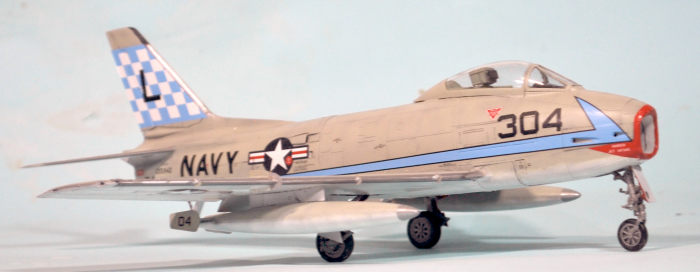 The
FJ-3 kit was first released in the spring of 2021, literally weeks before Kitty
Hawk announced the company was going out of business. Modelers scrambled to get
it as prices went up. It has new been re-released since Kityty Hawk was revived
this past spring. The original MSRP of $49.00 has increased to $64.99 (though
internet bargains can be found). The first run of the kit has sold out;
pre-orders for “Wave 2" are being taken at sites like Squadron Hobbies and
others.
The
FJ-3 kit was first released in the spring of 2021, literally weeks before Kitty
Hawk announced the company was going out of business. Modelers scrambled to get
it as prices went up. It has new been re-released since Kityty Hawk was revived
this past spring. The original MSRP of $49.00 has increased to $64.99 (though
internet bargains can be found). The first run of the kit has sold out;
pre-orders for “Wave 2" are being taken at sites like Squadron Hobbies and
others.
The kit differs from the earlier FJ-2 in replacing that kit’s Sprue A with a Sprue A carrying parts specific to the FJ-3, such as the slatless 6-3 wing.
As with the FJ-2 the kit decals are less that wonderful, with wrong-size national insignia and squadron markings that don’t quite fit, as well as BuNo decals that are not accurate for sub-type. Caracal Decals had released CD48173 and 48174, FJ-3 Parts 1 and 2, which include early Glossy Sea Blue airplanes (which can only be done by a mix-and-match of the two kits, using the FJ-2 wing on the FJ-3 fuselage), gull grey-and-white FJ-3 and 3Ms in Navy and Marine markings, and FJ-3Ds, as well as schemes for reserve aircraft. These decals are still available.
| CONSTRUCTION |
I assembled this kit with the wings spread, the flaps raised, and the gear doors, ammo doors and canopy closed. Doing so proved that this kit, like all other Kitty Hawk kits with lowered/opened options, really wants to be built the way I did with the FJ-2: wings folded, flaps dropped, and gear doors, ammo doors and canopy open. If you want a problem-free build, follow that option.
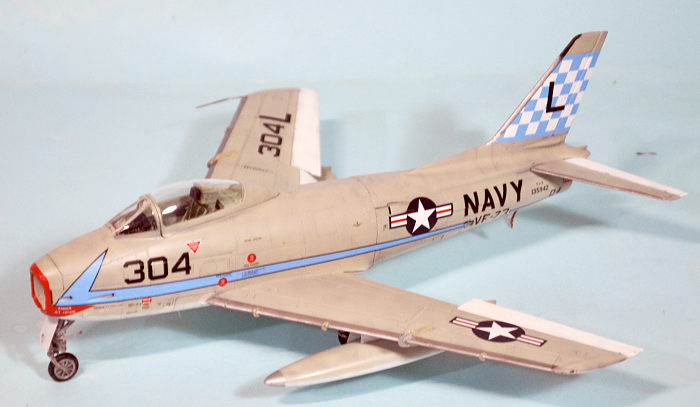 This
time, instead of cutting the frames to be inserted at the fuselage break points
of the fore and aft fuselage assemblies and then gluing everything into their
respective fuselage parts, which allowed me to assemble the fore and aft parts
of the fuselage to create two complete fuselage halves, I built the kit
according to instructions. This made everything more difficult and led to
poorfit between the fore and aft fuselage sections. I strongly uerge that if you
get this kit, you read my earlier review and assemble your model that way.
This
time, instead of cutting the frames to be inserted at the fuselage break points
of the fore and aft fuselage assemblies and then gluing everything into their
respective fuselage parts, which allowed me to assemble the fore and aft parts
of the fuselage to create two complete fuselage halves, I built the kit
according to instructions. This made everything more difficult and led to
poorfit between the fore and aft fuselage sections. I strongly uerge that if you
get this kit, you read my earlier review and assemble your model that way.
I closed the cannon bays before further assembly of the forward fuselage. The kit presents good basic material for the cannon bays and a super-detailer who wanted to put in the necessary wiring and such has got the basics to go for it. This also allowed me to work those cannon bay doors from inside and outside and get them perfectly aligned before applying any glue, since Kitty Hawk neglected to provide any nice “ledges” for them to attach to.
The cannon bays are necessary for structural support of the cockpit, but you don’t need the guns since they aren’t seen. After assembling and attaching the gun bays, I then assembled the intake trunking and the engine. You can’t see the engine unless you’re going to have it with the rear fuselage pulled away for a maintenance diorama. However, you do need the engine in there for the exhaust. I then assembled and painted the cockpit.
The FJ-2 and FJ-3 came from the factory with the cockpit and ejection seat painted in a “Teal” Green. When the FJ-3s went through overhaul following the official change of cockpit color for Navy airplanes to Dark Gull Grey, many (but not all) were repainted in this color. At some point in the production line, the cockpits were painted DGG, but this did not occur at some logical point like the changeover to the FJ-3M. Almost all photos of FJ-3s have the canopy closed, so one can only see the headrest of the seat. If it’s a color photo, one can differentiate between Teal and DGG. However, the cockpit the seat was in could be Teal or DGG with the seat in the opposite color or the same color. To top it off, FJ-3s with the different colors all served at the same time in squadrons. And the changeover to the ribbed elevators and rudders, which might signify the “color change” cannot be trusted, since early-production airplanes had these retrofitted at overhaul, when they might or might not have had the cockpit repainted. Thus, any guess you want to make is as good as any other, and nobody can prove you wrong since there are no color photos of operational FJ-3s with the canopy open and the cockpit visible in the shot.
I chose to do the cockpit and seat in “Teal.” I created the color using Tamiya XF-21 “Sky” out of the bottle with XF-4 “Flat Blue” in a mix of 4 parts XF-21 to 1 part XF-4. I used the kit decals for the instrument panels.
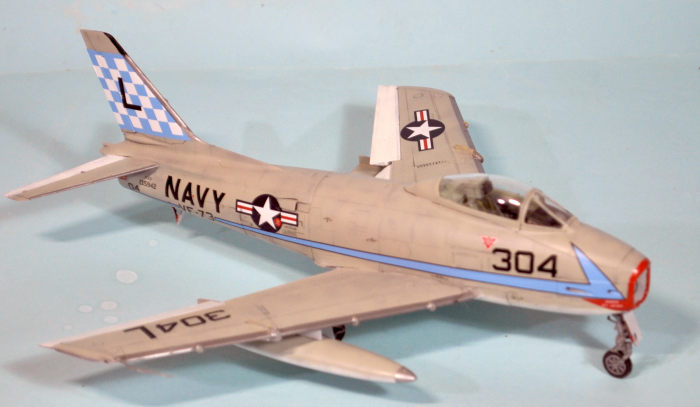 I
filled all the open speac inside the forward fuselage ahead of and immediately
behind the cocpit tub with fishweights, since the model is tail-heavy with the
engine installed.
I
filled all the open speac inside the forward fuselage ahead of and immediately
behind the cocpit tub with fishweights, since the model is tail-heavy with the
engine installed.
Regarding the wing subassembly, assembly of the wings up or down is equally easy, though if you are going to raise the flaps you need to cut out the ribbing inside the wing so the flap can sort of fit; but the wing part itself is a bit thick back there, so you don’t get a nice smooth junction between wing upper surface and flap. The easy fix as pointed out earlier is not to make this choice, which I did with this kit, opting to assemblete flaps down. Since I had decided to make an early FJ-3, which didn’thave a refueling probe until later, I filled the holes for the probe and the missile mounts. I glued the main gear doors in the closed position.
The kit provides the “ribbed” rudder and elevators found on late-production FJ-3s, which was also refitted to some (but not all!) earlier airplanes. Again, perhaps the appearance of these on the production line might have something to do with the cockpit color change, but since they were also refitted to earlier airplanes, no one can say with any certainty. I decided to do this one with early control surfaces, so I applied Mr. Surfacer to the ribbed areas and then sanded them smooth.
I glued the canopy on in the closed position, since the cockpit isn’t that nightly detailed but what can be seen through the very clear canopy in the closed position is adequate. Once the model was successfully assembled, it was time for paint.
| COLORS & MARKINGS |
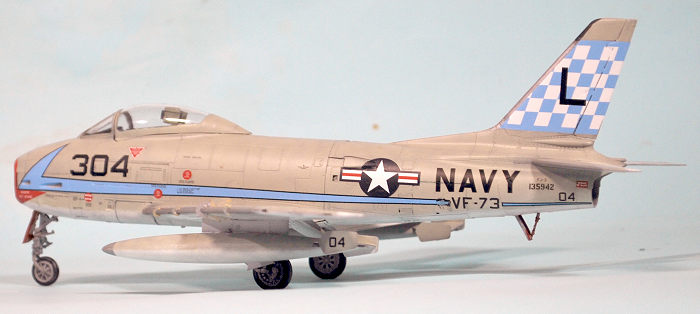 The
photo I found of the airplane I was doing showed some wear to the paint, with
the areas of panel lines darker (just like a model!). I preshaded the model with
Tamiya X-18 Semi-Gloss Black. I then painted leading edges of the weings and
tail surfaces with Tamiya Silver LP-11, then masked those areas off before
painting the lower surfaces with Mr. Color C-316 “White FS17875" and the upper
surfaces with Mr. Color C-11 “Light Gull Grey.”
The
photo I found of the airplane I was doing showed some wear to the paint, with
the areas of panel lines darker (just like a model!). I preshaded the model with
Tamiya X-18 Semi-Gloss Black. I then painted leading edges of the weings and
tail surfaces with Tamiya Silver LP-11, then masked those areas off before
painting the lower surfaces with Mr. Color C-316 “White FS17875" and the upper
surfaces with Mr. Color C-11 “Light Gull Grey.”
This early FJ-3 hadred wheel wells and interior surfaces of the gear doors, with the gear legs and wheel hubs painted with aluminum lacquer. I had-painted the gear wells and doors with Mr. Hobby H-88 “Red Madder,” and the gear legs with the Tamioya LP-11 Silver.
I went for the VF-73 “Jesters” FJ-3 aboard USS Randolph (CVA-15) in 1956, on the Caracal FJ-3 Fury Part 1 sheet, CD48173.
I gave the gloss white a coat of clear satin varnish to bring down the gloss surface to a more “scale” look, and gave the light gull grey a coat of clear flat. Then I assembled the landing gear and unmasked the canopy and decided to declare victory.
| CONCLUSIONS |
As I said in the 2021 review, this model is not one to just “throw together” per the Kitty Hawk instructions. Follow my map to the minefield of this kit in that review, and you can have a nice result. Because of all the difficulty of the assembly, I recommend the kit to experienced modelers. The result gives you an important addition to any collection of naval fighters or your Sabre collection.
Review kit courtesy of my wallet.
8 August 2024
Copyright ModelingMadness.com. All rights reserved. No reproduction in part or in whole without express permission.
If you would like your product reviewed fairly and fairly quickly, please contact the editor or see other details in the Note to Contributors.